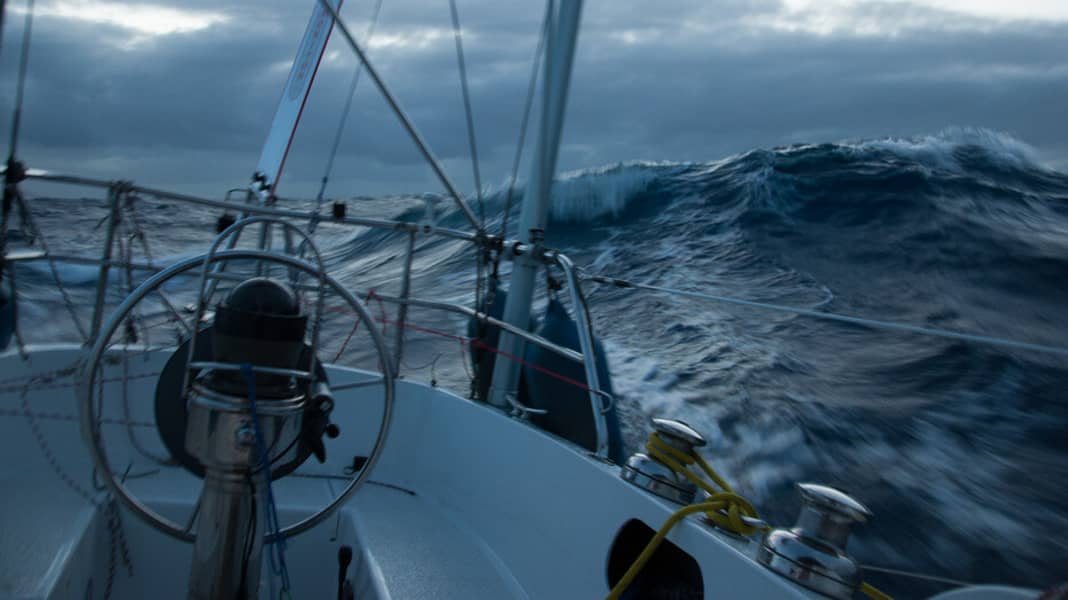
"What luck to have you lying next to me." Our neighbour Jim is still beside himself with excitement. Here in the small village of Camden, in the middle of North Carolina, a yacht that has sailed across the Atlantic is suddenly moored next to him. "Every morning when I get off the boat, I look at yours and think about what else I need to change so that I can get out on the Atlantic." Yesterday, in the Captain's Lounge (an air-conditioned lounge next to the laundry), Jim finally asks me the question that has been on his mind for a long time: "John, tell me ... What do I need to change on my boat to go offshore?"
Hmm ... Not an easy question. The boat is a Cape Dory 28, small but really beautifully and sturdily built. The rig is solid, the sails good, the engine more than adequately dimensioned. What can I say? "You have an autopilot, you have a stable dinghy that can be used as a lifeboat. A GPS, nautical charts?" The boat is actually ready to sail. At least if you compare it with the boats of the early circumnavigators, the Kochs, Schenks, Gebhards or Erdmänner.
The "Kairos" was just over nine metres long and had no autopilot. If Elga and Ernst-Jürgen Koch didn't want to steer themselves, they tried to make the ship steer itself with perfect trim and braided lines. The same went for Wilfried Erdmann and Rollo Gebhard, whose boats were only seven and a half metres long. In those days, most circumnavigators did not have a life raft with them, but at best a dinghy that they could inflate at a slightly faster pace using a compressed air pump. "So, strictly speaking, your boat already fulfils the minimum requirements for ocean sailing." An answer he probably wouldn't have expected.
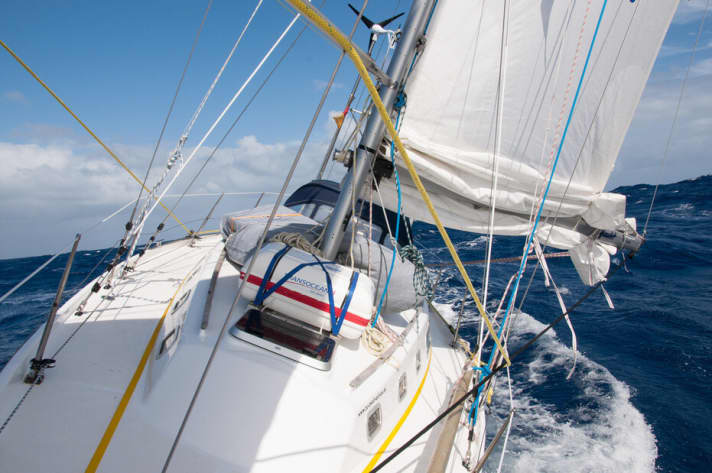
But there are many things that make life on board easier and safer - things that are better to have on board. A life raft is definitely better than a fixed dinghy. If only because of the capsize protection bags and the roof. An Epirb too. Preferably one with GPS, which makes it much easier for the rescue services - because they get a new position, not a signal to aim for. Tiller pilots and wheel pilots may work quite well for a while. We have met several yachts that have crossed entire oceans using only these self-steering systems, which are actually designed for use in the Baltic Sea.
But at some point they reach their limits. Usually when you can't use it. A solid autopilot system is essential for extended ocean voyages with a small crew. Either a windvane that doesn't need electricity or an electric autopilot that is installed below deck and thus protected from water and salty air. These things are now so robust and reliable that around 50 per cent of the ships we encounter underway can only be steered electrically. Provided, however, that the power supply works. Some yachts have sailed across the Atlantic and run diesel engines or generators every day to make up for the power consumption. However, if these fail, there is no backup. It's better to rely on wind and solar power and keep the engine as a backup power supply.
The American blue water sailor Gary "Cap'n Fatty" Goodlander may have a surprising nickname, but he is one of the most experienced American blue water sailors. He has lived on boats for 55 of his 63 years and has gained so much experience that he has his own column in almost every American and Caribbean blue water magazine. Yesterday I'm sitting over a coffee in the little petrol station, pick up a new issue of "All at sea", which is available free of charge everywhere here - and am amazed to read a three-page article by Cap'n Fatty that answers the exact question of when a yacht is ready for blue water. I quote:

"What do you REALLY need on a small sailing boat? Nothing that Joshua Slocum didn't have. The hull has to be solid, the rig up and the keel down. The yacht must be easy to steer. And it's reassuring if you can pump out any seawater that gets in. But apart from the hull, keel, rig, rudder and bilge pump - what else would you need? Most of these things are lighteners. You should keep that in mind. If the generator breaks down, the tricolour lantern too and the Epirb's battery leaks, that's stupid, but it doesn't endanger the safety of the ship at that moment. Of course, everything should be repaired as quickly as possible. But it doesn't prevent the ship from sailing."
A topic that can fill entire evenings at sailing get-togethers: What should be included? I remember an evening at the Hanseboot. Back then, old blue-water sailors were discussing which was better: that the dinghy had 10 or 25 hp. I had just returned from my first trip in a €6,000 eBay boat and was glad that I had a motor with me at all and didn't have to row.
The demands of old age may become greater when planning a blue water trip. I realise this myself, even though I'm not yet 30. I have often wondered what 19-year-old Johannes would have said if we had met him in the Caribbean and invited him on board. Unlike the first "Maverick", the "Maverick too" has a fridge. The fact that there are cold drinks would have been an incredible luxury for the 19-year-old. Technology is more advanced than back then. In the current YACHT 17/2015 you can find an article I wrote about the use of LED lamps on board. I haven't counted them yet, but I bet we have more than 300 LED bulbs on board. Indirect lamps, direct lamps, spotlights, ... On the first "Maverick" there was a single LED lamp with six small LEDs in the saloon. The other lamps were ordinary light bulbs, which I only used when I rarely had shore power. We always use a battery monitor to see exactly how much power is being fed into the batteries and how much is going out. Back then, I only had a simple voltmeter that usually displayed 11.7 volts, powered by a 20-watt solar panel that I borrowed from Uwe Röttgering. Until I was able to buy a half-broken wind generator cheaply in the Caribbean. Instead of 200 litres of water, I only had 70 in the tank.
Compared to "Maverick 1", "Maverick too" is really well equipped. But was I worse off back then without all that stuff? Not really. I was fine (even if I sometimes really smelled because of the small water reserves ;-)).
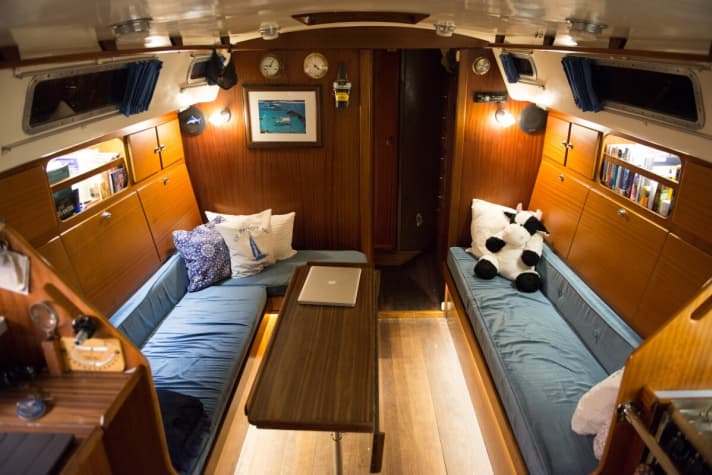
"Go small, go simple - but go now", say the blue water icons Lin and Larry Pardey once said. I think that was 30 years ago. And the two of them are still sailing. The 16-year-old circumnavigator Robin Lee Graham once coined the phrase: "At sea, you don't learn how much you need, you learn how little."
And indeed: on our Atlantic crossing, we needed a cooker to make our food and a wind steering system to keep us on course. A few books against boredom, a GPS to know where we were, and a bit of light on and below deck at night. And of course a good set of sails and a reliable engine. That's all.
As far as that goes, our "Maverick too" is completely over-equipped. But I'm no longer 19 either, and a little more comfort is fun as you get older.
Sailing a Spartan ship, on the other hand, has nothing to do with bad seamanship. Just because you don't have everything on board that the catalogue and the trade fair have to offer doesn't make you a worse sailor. I always have to quote Wilfried Erdmann, who equipped his "Kathena nui" really simply, "but of good quality". One of the most seaworthy yachts in Germany. Now it has a motor - but otherwise did not get any new equipment.
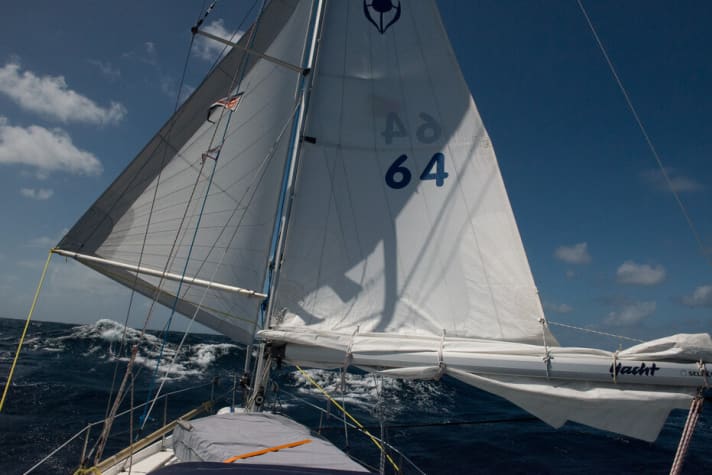
More important than many gadgets is that the skipper knows how to handle the ship and the challenges ahead. "Be prepared," says Goodlander, "be prepared." The storm will come. Important pieces of equipment will break. And then it's important to know where the tools are, which parts you can use to build a temporary solution. "Self-confidence at sea is not created by thinking that nothing will happen," summarises Goodlander. And by that he means false security through all kinds of equipment. "But rather by knowing that you yourself have the necessary skills and experience to find the right solutions."
At sea, this means keeping calm. Think clearly and logically about how the problem can be solved. What also helps is a saying that is right at the front of the operating instructions for our life raft. Even if the ship is sinking, "keep your sense of humour".
On my first trip across the Atlantic, the deck under the mast sagged because a laminated wooden core had become soft. As there was no DIY store on La Gomera (Canary Islands) and no other way to repair it, I put a thick stainless steel tube under the mast. The Americans call this a "compression post", which you also see on many small cruisers, to transfer the pressure of the mast to the keel. Without a source of wood, I had to get inventive and sawed up some old precious wood coat hangers and used them to build a very solid fixation for the tube. This supported the deck and nothing could happen. It lasted 5,000 miles. Then I sold the boat.
In the years that followed, many jokes were made about it: "He mended his boat with coat hangers and sailed across the Atlantic." But would it have been better if the wood had come from the DIY store rather than in coat hanger form? The solution was the best that could be made in the situation. To put it in the words of a car mechanic: "A good temporary solution is also quality."
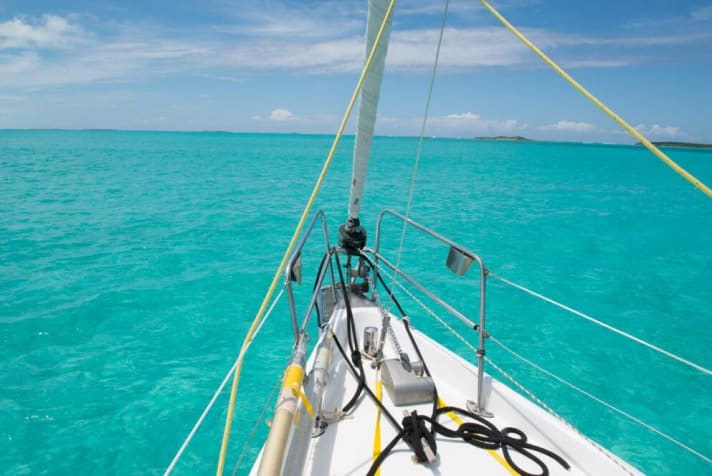
The important thing is to sail with your eyes open. To be prepared for something to go wrong. "It happens even with very good and extensive equipment," says Goodlander. And it is always important to remember: "The difference between a harrowing crossing and a great adventure lies in your attitude. Safe voyages on the high seas don't depend on nothing going wrong, but on dealing with the unexpected with confidence."
Further information about the trip: www.zu-zweit-auf-see.de

